高考英语语法专题复习动词时态和语态
- 格式:docx
- 大小:265.88 KB
- 文档页数:11
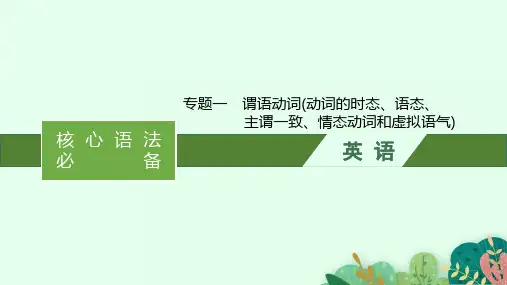
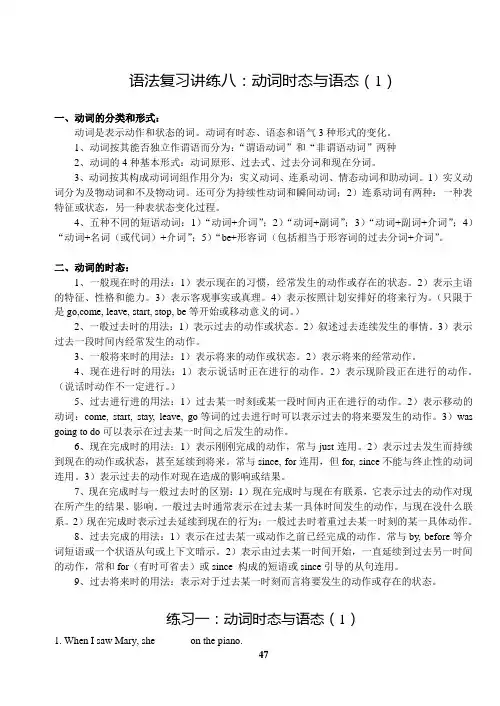
语法复习讲练八:动词时态与语态(1)一、动词的分类和形式:动词是表示动作和状态的词。
动词有时态、语态和语气3种形式的变化。
1、动词按其能否独立作谓语而分为:“谓语动词”和“非谓语动词”两种2、动词的4种基本形式:动词原形、过去式、过去分词和现在分词。
3、动词按其构成动词词组作用分为:实义动词、连系动词、情态动词和助动词。
1)实义动词分为及物动词和不及物动词。
还可分为持续性动词和瞬间动词;2)连系动词有两种:一种表特征或状态,另一种表状态变化过程。
4、五种不同的短语动词:1)“动词+介词”;2)“动词+副词”;3)“动词+副词+介词”;4)“动词+名词(或代词)+介词”;5)“be+形容词(包括相当于形容词的过去分词+介词”。
二、动词的时态:1、一般现在时的用法:1)表示现在的习惯,经常发生的动作或存在的状态。
2)表示主语的特征、性格和能力。
3)表示客观事实或真理。
4)表示按照计划安排好的将来行为。
(只限于是go,come, leave, start, stop, be等开始或移动意义的词。
)2、一般过去时的用法:1)表示过去的动作或状态。
2)叙述过去连续发生的事情。
3)表示过去一段时间内经常发生的动作。
3、一般将来时的用法:1)表示将来的动作或状态。
2)表示将来的经常动作。
4、现在进行时的用法:1)表示说话时正在进行的动作。
2)表示现阶段正在进行的动作。
(说话时动作不一定进行。
)5、过去进行进的用法:1)过去某一时刻或某一段时间内正在进行的动作。
2)表示移动的动词:come, start, stay, leave, go等词的过去进行时可以表示过去的将来要发生的动作。
3)was going to do可以表示在过去某一时间之后发生的动作。
6、现在完成时的用法:1)表示刚刚完成的动作,常与just连用。
2)表示过去发生而持续到现在的动作或状态,甚至延续到将来。
常与since, for连用,但for, since不能与终止性的动词连用。
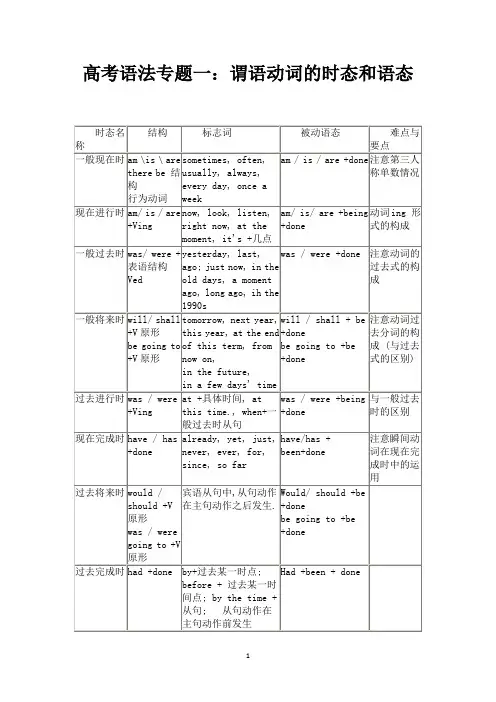
高考语法专题一:谓语动词的时态和语态一、时态的具体用法:(1) 一般现在时 表示现阶段经常或习惯发生的动作或存在的状态,或说明主语的特征。
① 一般现在时句子中常有的时间状语:often,usually,sometimes,always,every (day等), once/twice,a (week等), on (Sunday等),never,in the (morning等)。
如:They go to the Palace Museum once a year.(他们每年去一次故宫)/ They oftendiscuss business in the evening.(他们经常在晚上商谈生意)②表示客观真理、事实、人的技能或现在的状态时句子里一般不用时间状语。
如:The earth turns round the sun.(地球绕着太阳转)/ Light travels faster thansound.(光传播比声音快)③在条件状语从句中(以if,unless引导),用一般现在时代替一般将来时,句子可以有将来时间。
如:Please ring me up as soon as you arrive in Germany.(你一到德国就给我打电话) / If it rains tomorrow,we will have to stay at home.(如果明天下雨我们就只好呆在家)④人的心理活动和感官动作一般用一般现在时而不用现在进行时表达,常见动词有:like, love, hate, dislike, want, wish, hope, think(认为),understand, remember,forget, mean, need, hear, feel, see. 如:I think it is going to snow.(我想天要下雪了)/ I really hope you can enjoy your stay here.(我真的希望你愉快地呆在这儿)(2)一般过去时表示过去某时发生的动作或状态。
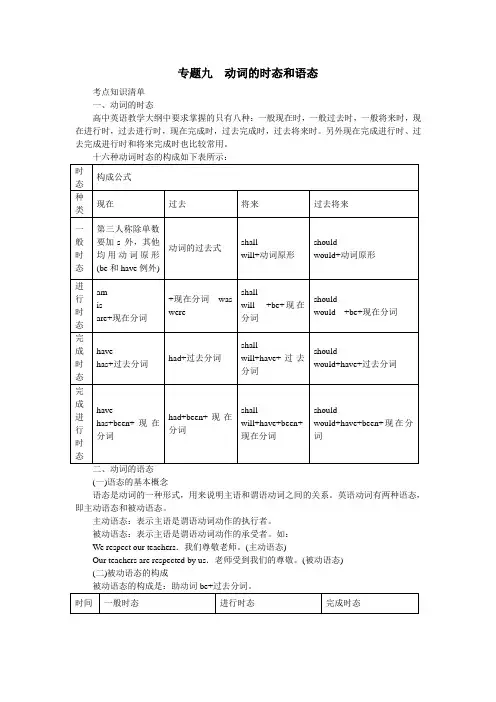
专题九动词的时态和语态考点知识清单一、动词的时态高中英语教学大纲中要求掌握的只有八种:一般现在时,一般过去时,一般将来时,现在进行时,过去进行时,现在完成时,过去完成时,过去将来时。
另外现在完成进行时、过去完成进行时和将来完成时也比较常用。
二、动词的语态(一)语态的基本概念语态是动词的一种形式,用来说明主语和谓语动词之间的关系。
英语动词有两种语态,即主动语态和被动语态。
主动语态:表示主语是谓语动词动作的执行者。
被动语态:表示主语是谓语动词动作的承受者。
如:We respect our teachers.我们尊敬老师。
(主动语态)Our teachers are respected by us.老师受到我们的尊敬。
(被动语态)(二)被动语态的构成知识梳理考点一一般现在时1.表示经常发生的习惯性的、现在反复出现的动作或状态,这类句子常用的时间状语有:always(总是),usually(通常),seldom(很少),often(经常),sometimes(有时),every day(每天),now and then(时常),once a week(一周一次)等。
如:I usually go to bed at nine.我通常9点钟睡觉。
He writes to his parents once a month.他每月给父母写一封信。
2.表示眼下或目前等现在时间所发生的动作或存在的状态,这种状态带有一定的持续性。
如:They are very busy.他们很忙。
What’s the matter with you?你怎么了?3.表示客观事实或普遍真理。
如:China is in the east of Asia.中国位于亚洲东部。
Light travels faster than sound.光比声音传得快。
4.书报的标题,故事的叙述,小说、戏剧、电影等情节介绍,图片的说明等。
如:The story takes place on an island during the second Revolution Civil War.这个故事发生在第二次国内革命战争时期的一个海岛上。
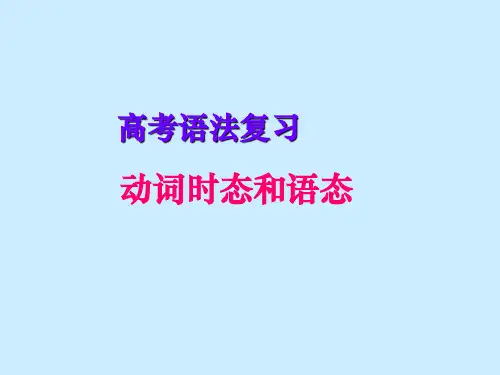
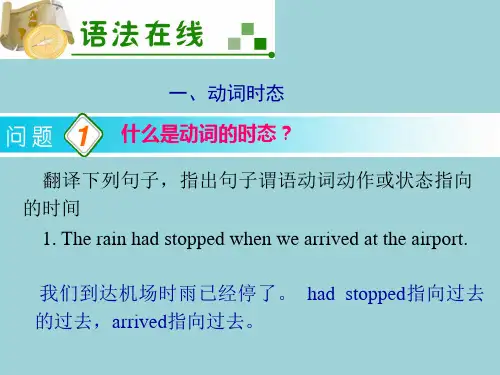
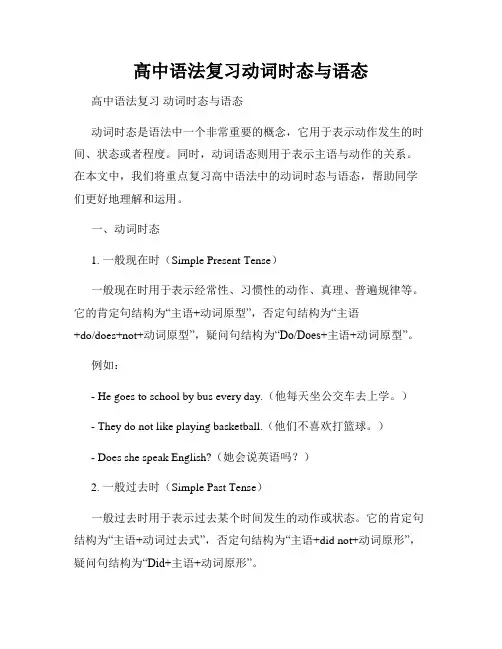
高中语法复习动词时态与语态高中语法复习动词时态与语态动词时态是语法中一个非常重要的概念,它用于表示动作发生的时间、状态或者程度。
同时,动词语态则用于表示主语与动作的关系。
在本文中,我们将重点复习高中语法中的动词时态与语态,帮助同学们更好地理解和运用。
一、动词时态1. 一般现在时(Simple Present Tense)一般现在时用于表示经常性、习惯性的动作、真理、普遍规律等。
它的肯定句结构为“主语+动词原型”,否定句结构为“主语+do/does+not+动词原型”,疑问句结构为“Do/Does+主语+动词原型”。
例如:- He goes to school by bus every day.(他每天坐公交车去上学。
)- They do not like playing basketball.(他们不喜欢打篮球。
)- Does she speak English?(她会说英语吗?)2. 一般过去时(Simple Past Tense)一般过去时用于表示过去某个时间发生的动作或状态。
它的肯定句结构为“主语+动词过去式”,否定句结构为“主语+did not+动词原形”,疑问句结构为“Did+主语+动词原形”。
例如:- I watched a movie last night.(昨晚我看了一场电影。
)- They did not go to the party.(他们没有参加派对。
)- Did you finish your homework?(你完成作业了吗?)3. 一般将来时(Simple Future Tense)一般将来时用于表示将来某个时间会发生的动作或状态。
它的肯定句结构为“主语+will+动词原形”,否定句结构为“主语+will not+动词原形”,疑问句结构为“Will+主语+动词原形”。
例如:- She will go to Beijing next week.(她下周将去北京。
)- We will not have a meeting tomorrow.(明天我们不开会。
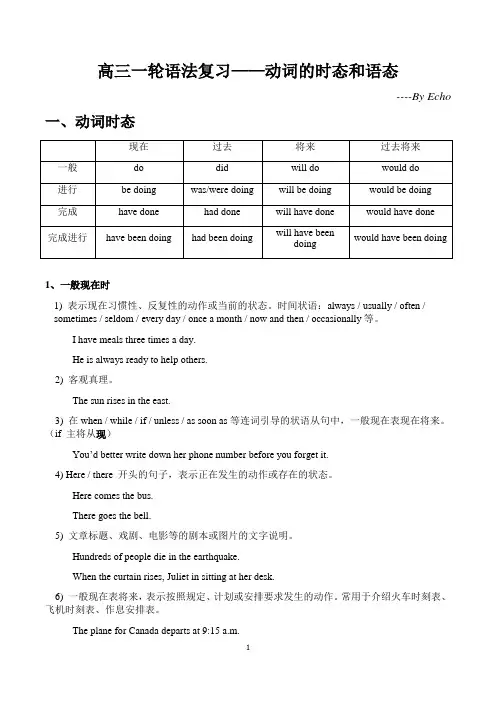
高三一轮语法复习——动词的时态和语态----By Echo 一、动词时态1、一般现在时1) 表示现在习惯性、反复性的动作或当前的状态。
时间状语:always / usually / often / sometimes / seldom / every day / once a month / now and then / occasionally等。
I have meals three times a day.He is always ready to help others.2) 客观真理。
The sun rises in the east.3) 在when / while / if / unless / as soon as等连词引导的状语从句中,一般现在表现在将来。
(if 主将从现)You’d better write down her phone number before you forget it.4) Here / there 开头的句子,表示正在发生的动作或存在的状态。
Here comes the bus.There goes the bell.5) 文章标题、戏剧、电影等的剧本或图片的文字说明。
Hundreds of people die in the earthquake.When the curtain rises, Juliet in sitting at her desk.6) 一般现在表将来,表示按照规定、计划或安排要求发生的动作。
常用于介绍火车时刻表、飞机时刻表、作息安排表。
The plane for Canada departs at 9:15 a.m.The programme ends at 11:10 p.m.2、一般过去时1)表示过去某个时间完成或一度存在的状态。
时间状语:then / yesterday / the other day / in 1990 / 5 years ago / last year等。
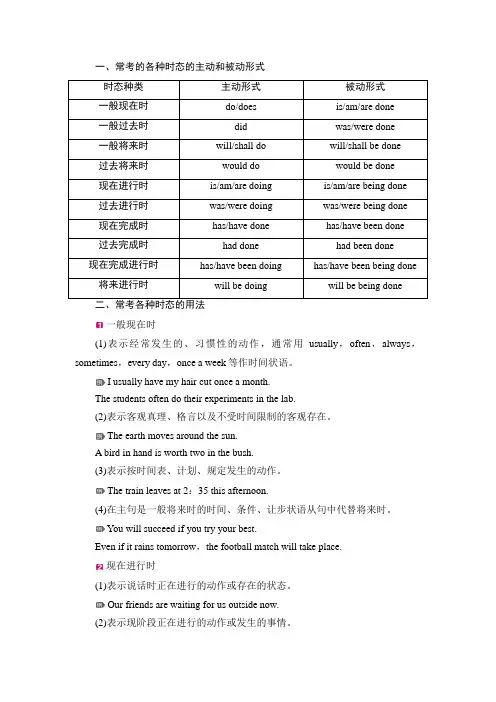
一、常考的各种时态的主动和被动形式一般现在时(1)表示经常发生的、习惯性的动作,通常用usually,often,always,sometimes,every day,once a week等作时间状语。
I usually have my hair cut once a month.The students often do their experiments in the lab.(2)表示客观真理、格言以及不受时间限制的客观存在。
The earth moves around the sun.A bird in hand is worth two in the bush.(3)表示按时间表、计划、规定发生的动作。
The train leaves at 2:35 this afternoon.(4)在主句是一般将来时的时间、条件、让步状语从句中代替将来时。
You will succeed if you try your best.Even if it rains tomorrow,the football match will take place.现在进行时(1)表示说话时正在进行的动作或存在的状态。
Our friends are waiting for us outside now.(2)表示现阶段正在进行的动作或发生的事情。
She is learning English at college.(3)某些短暂性动词,如come,go,start,open,close,arrive,return,begin,leave等用于进行时,表示按计划、安排即将发生的动作。
My father is coming to see me this Saturday.He is leaving for Beijing next week.(4)某些动词的进行时表示慢慢地、渐渐地发生变化。
I'm forgetting English.She is losing her eyesight.表示存在、拥有、认知、情感等的动词一般不用于进行时态,常见的有keep,stay,remain,consist of,contain,have,belong to,possess,own,hold,sound,look,seem,appear,smell,taste,feel,see,hear,understand,know,suppose,remember,admit,forget,believe,think,like,love,hate,prefer等。
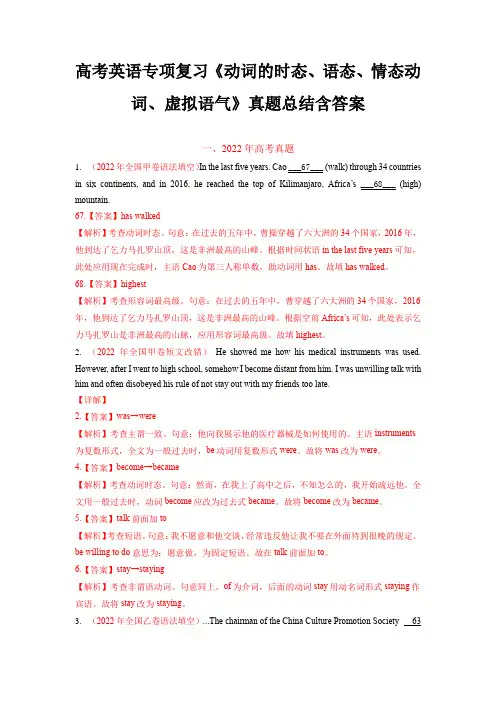
高考英语专项复习《动词的时态、语态、情态动词、虚拟语气》真题总结含答案一、2022年高考真题1.(2022年全国甲卷语法填空)In the last five years. Cao ___67___ (walk) through 34 countries in six continents, and in 2016, he reached the top of Kilimanjaro, Africa’s ___68___(high) mountain.67.【答案】has walked【解析】考查动词时态。
句意:在过去的五年中,曹操穿越了六大洲的34个国家,2016年,他到达了乞力马扎罗山顶,这是非洲最高的山峰。
根据时间状语in the last five years可知,此处应用现在完成时,主语Cao为第三人称单数,助动词用has。
故填has walked。
68.【答案】highest【解析】考查形容词最高级。
句意:在过去的五年中,曹穿越了六大洲的34个国家,2016年,他到达了乞力马扎罗山顶,这是非洲最高的山峰。
根据空前Africa’s可知,此处表示乞力马扎罗山是非洲最高的山脉,应用形容词最高级。
故填highest。
2.(2022年全国甲卷短文改错)He showed me how his medical instruments was used. However, after I went to high school, somehow I become distant from him. I was unwilling talk with him and often disobeyed his rule of not stay out with my friends too late.【详解】2.【答案】was→were【解析】考查主谓一致。
句意:他向我展示他的医疗器械是如何使用的。
主语instruments 为复数形式,全文为一般过去时,be动词用复数形式were。
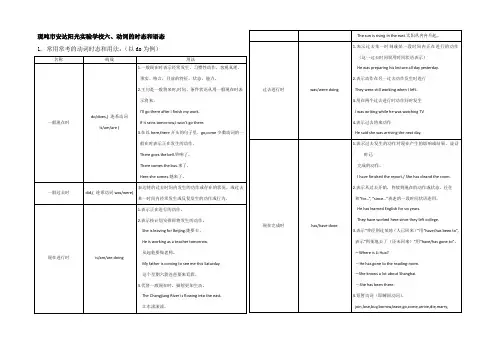
模块三千变万化的动词第4讲动词的时态、语态和主谓一致考点一一般时态1. 一般现在时(do/does;is/am/are)(1)表示经常发生的、习惯性的、反复出现的动作或状态。
常与表示习惯的副词(词组)always,every time,now and then,occasionally,often,seldom,sometimes,usually, every day/night等连用。
(2)按时间表、时刻表、日程表等安排将要发生的动作,用一般现在时。
只限于go,arrive,leave,start,stay,return,begin,come等动词。
(3)普遍真理。
(4)用在时间、条件或让步状语从句中,用一般现在时表示将来。
※He plays basketball every day.※The film starts at two o’clock.※The earth goes round the sun once a year.※(2020·江苏高考)If you look at all sides of the situation, you’ll find probablya solution that suits everyone.2. 一般过去时(did;was/were)(1)表示过去某个时间发生的动作或情况。
(2)表示过去习惯性动作。
点津: would/used to do表示过去常常做……※We used to go there every year.※We often played together when we were children.※—Haven’t seen you for ages! Where have you been?—I went to Ningxia and stayed there for three years, teaching as a volunteer. 考点二进行时态1. 现在进行时(am/is/are doing)(1)表示说话时正在进行或表示现阶段正在进行的动作,虽然此时此刻该动作不一定正在进行。
高考英语语法专题复习动词时态和语态Document number:PBGCG-0857-BTDO-0089-PTT1998高考英语语法复习专题:动词时态和语态一、考点聚焦1、动词时态考查要点简述(1)一般现在时考点分析①表示客观事实或普通真理(不受时态限制)The geography teacher told us the earth moves around the sun.Water boils at 100o C.②表示现状、性质、状态时多用系动词或状态动词;表示经常或习惯性的动作,多用动作动词,且常与表频率的时间状语连用。
Ice feels cold.We always care for each other and help each other.③表示知觉、态度、感情、某种抽象的关系或概念的词常用一般现在时:see、hear、smell、taste、feel、notice、agree、believe、like、hate、want、think、belong seem等。
如:I know what you mean.Smith owns a car and a house.All the students here belong to Middle School.④在时间、条件状语从句中常用一般现在时代替将来时。
但要注意由if 引导的条件状语从句中可以用shall或will表“意愿”,但不表示时态。
If you will accept my invitation and come to our party, my family will be pleased.如果你愿意接受并参加我们的舞会,我的家人会非常高兴。
⑤少数用于表示起止的动词如come、go、leave、arrive、fly、return、start、begin、pen、close、end、stop等常用一般现在时代替将来时,表示一个按规定、计划或安排要发生的动作。
当be表示根据时间或事先安排,肯定会出现的状态,只用一般现在时。
The shop closes at 11:00 . every day.Tomorrow is Wednesday.(2)一般过去时的考点分析(考核重点)。
①一般过去时的基本用法:表示过去的事情、动作或状态常与表示过去具体的时间状语连用(或有上下文语境暗示);用于表达过去的习惯;表示说话人原来没有料到、想到或希望的事通常用过去式。
如:I met her in the street yesterday.I once saw the famous star here.They never drank wine.I thought the film would be in teresting,but it isn’t.②如果从句中有一个过去的时间状语,尽管从句中的动作先于主句发生,但从句中的谓语动词连用过去式。
如:He told me he read an interesting novel last night.③表示两个紧接着发生的动作,常由以下词语连接,用一般过去时。
如:but, and, when, as soon as, immediately, the moment, the minute。
The moment she came in, she told me what had happened to her.He bought a watch but lost i t.④常用一般过去时的句型:Why didn’t you / I think of that?I didn’t notice it.I forgot to tell you I had been there with my brother before.I didn’t recognize him.(3)一般将来时考点分析。
①表示未来的动作或状态常用will / shall + 动词(常与表示将来的时间状语边用如tomorrow、next week等)。
②表示一种趋向或习惯动作。
We’ll die without air or water.③表示趋向行为的动词如come、go、start、begin、leave等词常用进行时的形式表示将来时。
④be going to与will / shall, be to do, be about to do用法及区别:be going to 表示现在打算在最近或将来要做某事,这种打算往往经过事先考虑,甚至已做了某种准备;shall / will do表示未事先考虑过,即说话时临时作出的决定。
be going to 表将来,不能用在条件状语从句的主句中;而will则能,表意愿。
如:I f it is fine, we’ll go fishing.(正确)If it is fine, we are going to go fishing.(错误)be to do sth.表按计划、安排即将发生的动作,还可表示吩咐、命令、禁止,可能性等。
A meeting is to be held at 3:00 o’clock this afternoon.be about to do sth.表示“即可,就要”,后面不能接时间状语或状语从句。
Autumn harvest is about to start.(4)现在进行时考点分析。
①表示说话时正在发生着的一个动作;表示现阶段但不一定是发生在讲话时;表近期特定的安排或计划;go、come等起止动作可用进行时代替将来时。
如:It i s raining now.He is teaching English and learning Chinese.I am meeting Mr. Wang tonight.We are leaving on Friday.At six I am bathing the baby.(I start bathing the bady before six.)The girl is always talking loud in public.(与always、often等频度副词连用,表经常反复的行动或某种感情色彩)②下面四类动词不宜用现在进行时。
(A)表示心理状态、情感的动作:like, love, hate, care, remember, believe, want, mind, wish, agree, mean, need。
(B)表存在的状态的动词:appear, exist, lie, remain, seem belong to, dependon。
(C)表示一时性动作的动词:allow, accept, permit, promise, admit, complete。
(D)表示感官的动词:see, hear, notice, feel, smell, sound, taste, look。
(5)过去完成时考点分析(考核重点)。
①常用过去完成时的几种情况:(A)在by、by the end、by the time、until、before、since后接表示过去某一时间的短语或从句以前发生的动作。
如:By the end of last year, we had produced 20,000 cars. The train had left before we reached the station. (B)表示曾实现的希望、打算、意图、诺言等。
常用had hoped / planned / meant / intended/though / wanted / expected等或用上述动词过去式接不定式完成式表示即:hoped / planned … + to have done。
(C)“时间名词 + before”在句子中作状语,谓语动词用过去完成时;“时间名词 + ago”在句中作状语,谓语动词用一般过去式。
如:He said his first teacher had died at least 10 years before. Xiao Hua left school 3 years ago.(D)表示“一……就”的几个句型:Hardly / No sooner / Scarcely had + 主语 + 过去分词 + when / than / before + 一般过去时。
如:We had no sooner been seated than the bus started. = No sooner had we been seated than the bus started.②在before或after引导的时间状语从句中用一般过去时态代替过去完成时。
After he (had)left the room, the boss came in.We arrived home before it snowed.(6)过去将来时考点分析。
参照一般将来时对比:用would do、was / were going to do sth.表过去将来;come、go、leave等过去进行时表过去将来时;was / were to do sth.和was / were about to do sth.表过去将来。
(7)过去进行时考点分析。
①过去某一时刻正在进行的动作或某一阶段内发生或频繁发生。
②某一动作发生时另一动作正在发生,其中一个在由when或while引导的时间状语从句中。
(8)现在完成时考点分析。
①现在完成时除可以和for、since引导的状语连用外,还可以和下面的介词短语连用:during / in /over the last(past)few years (months, weeks)、in recent years 等。
②下列句型中常用现在完成时It is (has been) + 一段时间 + since从句This(That / It)is the first(second…)time that +完成时This(That / It)is the only … + that + 完成时This(that / It)is the best / finest / most interesting … + that 从句 + 完成时③在时间或条件状语从句中,现在完成时可以代替一般将来时。
如:I shall post the letter as soon as I have written it.If you have done the experiment, you will realize the theory better.Don’t get off the bus until it has stopped.(9)注意几组时态的区别:①一般过去时与现在完成时:时间上有差异:凡有过去时间的均用过去时态,不能用完成时态,如含有ago、last year、just now、the other day等。